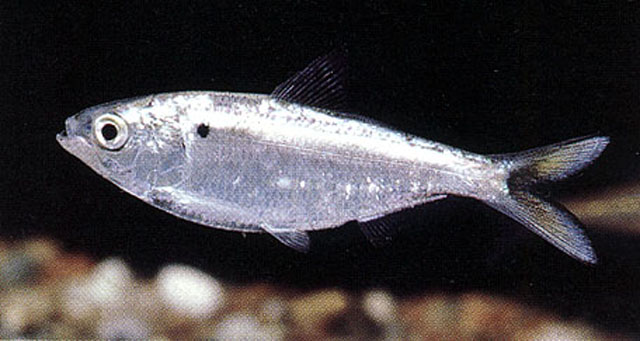| Dorosomatidae (Gizzard shads and sardinellas) |
| 33 cm TL (male/unsexed); max. reported age: 4 years |
|
pelagic-neritic; freshwater; brackish; marine; depth range 0 - 15 m, anadromous |
| North and Central America: Gulf of Mexico drainage, Mississippi system, from the Ohio River of Kentucky and southern Indiana southwest to Oklahoma, and south to Texas and Florida, also rivers around the Gulf to northern Guatemala; also Belize River, British Honduras. Introduced in Hawaiian waters (Ref. 188) and in Chesapeake Bay tributaries (Ref. 93252). |
|
Dorsal spines (total): 0-0; Dorsal soft rays (total): 11-15; Anal spines: 0-0; Anal soft rays: 17-27; Vertebrae: 43-44. Body moderately deep; belly with 15 to 18 + 8 to 12 scutes. Mouth small. Last dorsal fin ray long, about equal to distance from snout tip to mid-pectoral fin or beyond; anal fin relatively short. Scales relatively large, regularly arranged. A dark spot behind gill opening. Gill rakers fine and numerous (Ref. 188). Body bright silvery, especially on sides, opercles and underparts. Back and upper sides bluish black or dark olivaceous (Ref. 37032). |
| Often schooling, occurring mainly in freshwater (in large rivers, reservoirs, lakes, and swamps). Prefer the presence of smooth, steep-sided surfaces such as dams, cement-lined pools and rip rapped streams (Ref. 39049). But adults are also found in brackish or saline water of estuaries and bays (up to 32.3 ppt salinity (Ref. 39050); juveniles to about 15 ppt). Larvae are pelagic probably found only in freshwater (Ref. 39046). Filter-feeders, but not entirely herbivorous since recorded food items include copepods, cladocerans and fish fry. Also feed on organic material of sand and detritus bottoms (Ref. 9114). Breed in the spring and in autumn, in freshwater, near or over plants or other objects. Eggs adhere to aquatic vegetation (Ref. 4639). Caught exclusively in fresh waters and sometimes in mouths of rivers (Ref. 9291). Also Ref. 58302. |
|
Least Concern (LC); Date assessed: 24 October 2018 Ref. (130435)
|
| harmless |
Source and more info: www.fishbase.org. For personal, classroom, and other internal use only. Not for publication.
